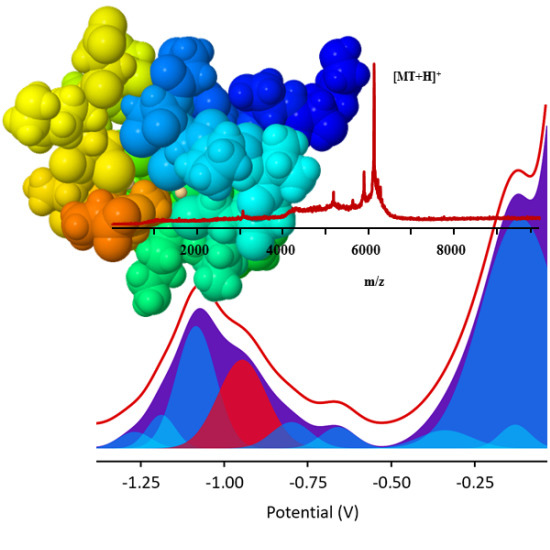The Application of Curve Fitting on the Voltammograms of Various Isoforms of Metallothioneins–Metal Complexes
Abstract
:1. Introduction
1.1. Metallothioneins
1.2. Evaluation of Non-Resolved Voltammetric Signals
2. Results and Discussion
2.1. Characterization of MTs by matrix-assisted laser desorption/ionization time-of-flight mass spectrometry (MALDI-TOF MS)
2.2. Optimization of Electrochemical Detection for Determination of MT by Using NaCl as Supporting Electrolyte
2.3. The Application of Curve Fitting on Non-Resolved Voltammetric Signals of Metal-MT Complexes
3. Materials and Methods
3.1. Reagents and Chemicals
3.2. Isolation of MTs and Construction of Plasmids for Heterologous Expression of MTs
3.3. The Matrix-Assisted Laser Desorption/Ionization Time-of-Flight Mass Spectrometry (MALDI-TOF MS)
3.4. Electrochemical Measurements
3.5. Software Used for Data Collection and Evaluation
4. Conclusions
Supplementary Materials
Acknowledgments
Author Contributions
Conflicts of Interest
References
- Kojima, Y. Definitions and nomenclature of metallothioneins. Method Enzymol. 1991, 205, 8–10. [Google Scholar]
- Margoshes, M.; Vallee, B.L. A cadmium protein from equine kidney cortex. J. Am. Chem. Soc. 1957, 79, 4813–4814. [Google Scholar] [CrossRef]
- Klaassen, C.D.; Liu, J.; Diwan, B.A. Metallothionein protection of cadmium toxicity. Toxicol. Appl. Pharmacol. 2009, 238, 215–220. [Google Scholar] [CrossRef] [PubMed]
- Park, J.D.; Liu, Y.P.; Klaassen, C.D. Protective effect of metallothionein against the toxicity of cadmium and other metals. Toxicology 2001, 163, 93–100. [Google Scholar] [CrossRef]
- Heger, Z.; Zitka, J.; Cernei, N.; Krizkova, S.; Sztalmachova, M.; Kopel, P.; Masarik, M.; Hodek, P.; Zitka, O.; Adam, V.; et al. 3D-printed biosensor with poly(dimethylsiloxane) reservoir for magnetic separation and quantum dots-based immunolabeling of metallothionein. Electrophoresis 2015, 36, 1256–1264. [Google Scholar] [CrossRef] [PubMed]
- Tmejova, K.; Hynek, D.; Kopel, P.; Gumulec, J.; Krizkova, S.; Guran, R.; Heger, Z.; Kalina, M.; Vaculovicova, M.; Adam, V.; et al. Structural effects and nanoparticle size are essential for quantum dots-metallothionein complex formation. Colloid Surf. Biointerfaces 2015, 134, 262–272. [Google Scholar] [CrossRef] [PubMed]
- Babu, C.S.; Lee, Y.M.; Dudev, T.; Lim, C. Modeling Zn2+ release from metallothionein. J. Phys. Chem. A 2014, 118, 9244–9252. [Google Scholar] [CrossRef] [PubMed]
- Liu, C.B.; He, X.Y.; Hong, X.R.; Kang, F.H.; Chen, S.Q.; Wang, Q.; Chen, X.Q.; Hu, D.; Sun, Q.H. Suppression of placental metallothionein 1 and zinc transporter 1 mRNA expressions contributes to fetal heart malformations caused by maternal zinc deficiency. Cardiovasc. Toxicol. 2014, 14, 329–338. [Google Scholar] [CrossRef] [PubMed]
- Hwang, J.J.; Lee, S.J.; Kim, T.Y.; Cho, J.H.; Koh, J.Y. Zinc and 4-hydroxy-2-nonenal mediate lysosomal membrane permeabilization induced by H2O2 in cultured hippocampal neurons. J. Neurosci. 2008, 28, 3114–3122. [Google Scholar] [CrossRef] [PubMed]
- Lee, S.J.; Koh, J.Y. Roles of zinc and metallothionein-3 in oxidative stress-induced lysosomal dysfunction, cell death, and autophagy in neurons and astrocytes. Mol. Brain 2010, 3, 1–9. [Google Scholar] [CrossRef] [PubMed]
- Torreggiani, A.; Domenech, J.; Atrian, S.; Capdevila, M.; Tinti, A. Raman study of in vivo synthesized Zn(II)-metallothionein complexes: Structural insight into metal clusters and protein folding. Biopolymers 2008, 89, 1114–1124. [Google Scholar] [CrossRef] [PubMed]
- Gehrig, P.M.; You, C.H.; Dallinger, R.; Gruber, C.; Brouwer, M.; Kagi, J.H.R.; Hunziker, P.E. Electrospray ionization mass spectrometry of zinc, cadmium, and copper metallothioneins: Evidence for metal-binding cooperativity. Protein Sci. 2000, 9, 395–402. [Google Scholar] [CrossRef] [PubMed]
- Adam, V.; Petrlova, J.; Wang, J.; Eckschlager, T.; Trnkova, L.; Kizek, R. Zeptomole electrochemical detection of metallothioneins. PLoS ONE 2010, 5, e11441. [Google Scholar] [CrossRef] [PubMed]
- Sobrova, P.; Vyslouzilova, L.; Stepankova, O.; Ryvolova, M.; Anyz, J.; Trnkova, L.; Adam, V.; Hubalek, J.; Kizek, R. Tissue specific electrochemical fingerprinting. PLoS ONE 2012, 7, e49654. [Google Scholar] [CrossRef] [PubMed]
- Adam, V.; Fabrik, I.; Eckschlager, T.; Stiborova, M.; Trnkova, L.; Kizek, R. Vertebrate metallothioneins as target molecules for analytical techniques. Trends Anal. Chem. 2010, 29, 409–418. [Google Scholar] [CrossRef]
- Jakubowska, M. Signal processing in electrochemistry. Electroanalysis 2011, 23, 553–572. [Google Scholar] [CrossRef]
- Alberich, A.; Arino, C.; Diaz-Cruz, J.M.; Esteban, M. Soft modelling for the resolution of highly overlapped voltammetric peaks: Application to some Pb-phytochelatin systems. Talanta 2007, 71, 344–352. [Google Scholar] [CrossRef] [PubMed]
- Lopez, M.J.; Arino, C.; Diaz-Cruz, S.; Diaz-Cruz, J.M.; Tauler, R.; Esteban, M. Voltammetry assisted by multivariate analysis as a tool for speciation of metallothioneins: Competitive complexation of α and β-metallothionein domains with cadmium and zinc. Environ. Sci. Technol. 2003, 37, 5609–5616. [Google Scholar] [CrossRef] [PubMed]
- Cruz, B.H.; Diaz-Cruz, J.M.; Arino, C.; Esteban, M. Complexation of heavy metals by phytochelatins: Voltammetric study of the binding of Cd2+ and Zn2+ ions by the phytochelatin (γ-glu-cys)3gly assisted by multivariate curve resolution. Environ. Sci. Technol. 2005, 39, 778–786. [Google Scholar] [CrossRef] [PubMed]
- Pižeta, I.; Omanović, D.; Branica, M. The influence of data treatment on the interpretation of experimental results in voltammetry. Anal. Chim. Acta 1999, 401, 163–172. [Google Scholar] [CrossRef]
- Omanović, D.; Garnier, C.; Louis, Y.; Lenoble, V.; Mounier, S.; Pižeta, I. Significance of data treatment and experimental setup on the determination of copper complexing parameters by anodic stripping voltammetry. Anal. Chim. Acta 2010, 664, 136–143. [Google Scholar] [CrossRef] [PubMed]
- Pižeta, I. Deconvolution of non-resolved voltammetric signals. Anal. Chim. Acta 1994, 285, 95–102. [Google Scholar] [CrossRef]
- Zelić, M.; Pižeta, I.; Branica, M. Study of cadmium adsorption from iodide media by voltammetry combined with data treatment by deconvolution. Anal. Chim. Acta 1993, 281, 63–70. [Google Scholar] [CrossRef]
- Slowey, A.J.; Marvin-DiPasquale, M. How to overcome inter-electrode variability and instability to quantify dissolved oxygen, Fe(II), Mn(II), and S(-II) in undisturbed soils and sediments using voltammetry. Geochem. Trans. 2012, 13, 1–20. [Google Scholar] [CrossRef] [PubMed]
- Garbellini, G.S.; Uliana, C.V.; Yamanaka, H. Detection of DNA nucleotides on pretreated boron doped diamond electrodes. J. Braz. Chem. Soc. 2011, 22, 1241–1245. [Google Scholar] [CrossRef]
- Engblom, S.O. The fourier transform of a voltammetric peak and its use in resolution enhancement. J. Electroanal. Chem. 1990, 296, 371–394. [Google Scholar] [CrossRef]
- Bucur, R.V. Structure of the voltammograms of the platinum-black electrodes: Derivative voltammetry and data fitting analysis. Electrochim. Acta 2014, 129, 76–84. [Google Scholar] [CrossRef]
- Pižeta, I.; Lovrić, M.; Zelić, M.; Branica, M. Application of a fourier transform method to the resolution enhancement of adsorption peaks in differential pulse polarography. J. Electroanal. Chem. 1991, 318, 25–38. [Google Scholar] [CrossRef]
- Economou, A.; Fielden, P.R.; Packham, A.J. Deconvolution of analytical peaks by means of the fast hartley transform. Analyst 1996, 121, 1015–1018. [Google Scholar] [CrossRef]
- Lu, X.Q.; Mo, J.Y.; Kang, J.W.; Gao, J.Z. Method of processing discrete data for deconvolution voltammetry—(ii) Spline wavelet transformation. Anal. Lett. 1998, 31, 529–540. [Google Scholar]
- Engblom, S.O. Properties and applications of the fourier transform of a voltammetric wave. J. Electroanal. Chem. 1992, 332, 73–99. [Google Scholar] [CrossRef]
- Raspor, B.; Ivanka, P.; Branica, M. Comparative quantitative analysis of overlapping voltammetric signals. Anal. Chim. Acta 1994, 285, 103–111. [Google Scholar] [CrossRef]
- Gutknech, W.F.; Perone, S.P. Numerical deconvolution of overlapping stationary electrode polarographic curves with an on-line digital computer. Anal. Chem. 1970, 42, 906–917. [Google Scholar]
- Boudreau, P.A.; Perone, S.P. Quantitative resolution of overlapped peaks in programmed potential-step voltammetry. Anal. Chem. 1979, 51, 811–817. [Google Scholar] [CrossRef]
- Romanenko, S.V.; Stromberg, A.G.; Selivanova, E.V.; Romanenko, E.S. Resolution of the overlapping peaks in the case of linear sweep anodic stripping voltammetry via curve fitting. Chemometrics Intell. Lab. Syst. 2004, 73, 7–13. [Google Scholar] [CrossRef]
- Lehmann, E.; Zenobi, R.; Vetter, S. Matrix-assisted laser desorption/ionization mass spectra reflect solution-phase zinc finger peptide complexation. J. Am. Soc. Mass Spectrom. 1999, 10, 27–34. [Google Scholar] [CrossRef]
- Nejdl, L.; Nguyen, H.V.; Richtera, L.; Krizkova, S.; Guran, R.; Masarik, M.; Hynek, D.; Heger, Z.; Lundberg, K.; Erikson, K.; et al. Label-free bead-based metallothionein electrochemical immunosensor. Electrophoresis 2015, 36, 1894–1904. [Google Scholar] [CrossRef] [PubMed]
- Ruiz, C.; Rodriguez, A.R. Characterisation of human metallothioneins from foetal liver and adult kidney using differential pulse polarography. Anal. Chim. Acta 1997, 350, 305–317. [Google Scholar] [CrossRef]
- Adam, V.; Petrlova, J.; Potesil, D.; Zehnalek, J.; Sures, B.; Trnkova, L.; Jelen, F.; Kizek, R. Study of metallothionein modified electrode surface behavior in the presence of heavy metal ions-biosensor. Electroanalysis 2005, 17, 1649–1657. [Google Scholar] [CrossRef]
- Nieto, O.; Hellemans, G.; Bordin, G.; de Ley, M.; Rodriguez, A.R. Characterisation of human foetal liver Zn-metallothioneins using differential pulse polarography. Talanta 1998, 46, 315–324. [Google Scholar] [CrossRef]
- Adam, V.; Krizkova, S.; Zitka, O.; Trnkova, L.; Petrlova, J.; Beklova, M.; Kizek, R. Determination of apo-metallothionein using adsorptive transfer stripping technique in connection with differential pulse voltammetry. Electroanalysis 2007, 19, 339–347. [Google Scholar] [CrossRef]
- Adam, V.; Petrlova, J.; Potesil, D.; Lubal, P.; Zehnalek, J.; Sures, B.; Kizek, R. New electrochemical biosensor to determine platinum cytostatics to DNA structure. Chem. Listy 2005, 99, 353–393. [Google Scholar]
- Erk, M.; Raspor, B. Evaluation of cadmium–metallothionein stability constants based on voltammetric measurements. Anal. Chim. Acta 1998, 360, 189–194. [Google Scholar] [CrossRef]
- Skalickova, S.; Zitka, O.; Nejdl, L.; Krizkova, S.; Sochor, J.; Janu, L.; Ryvolova, M.; Hynek, D.; Zidkova, J.; Zidek, V.; et al. Study of interaction between metallothionein and CdTe quantum dots. Chromatographia 2013, 76, 345–353. [Google Scholar] [CrossRef]
- Hrbac, J.; Halouzka, V.; Trnkova, L.; Vacek, J. El-chem viewer: A freeware package for the analysis of electroanalytical data and their post-acquisition processing. Sensors 2014, 14, 13943–13954. [Google Scholar] [CrossRef] [PubMed]
- Petrlova, J.; Potesil, D.; Zehnalek, J.; Sures, B.; Adam, V.; Trnkova, L.; Kizek, R. Cisplatin electrochemical biosensor. Electrochim. Acta 2006, 51, 5169–5173. [Google Scholar] [CrossRef]
- Adam, V.; Hanustiak, P.; Krizkova, S.; Beklova, M.; Zehnalek, J.; Trnkova, L.; Horna, A.; Sures, B.; Kizek, R. Palladium biosensor. Electroanalysis 2007, 19, 1909–1914. [Google Scholar] [CrossRef]
- Krizkova, S.; Adam, V.; Petrlova, J.; Zitka, O.; Stejskal, K.; Zehnalek, J.; Sures, B.; Trnkova, L.; Beklova, M.; Kizek, R. A suggestion of electrochemical biosensor for study of platinum(II)-DNA interactions. Electroanalysis 2007, 19, 331–338. [Google Scholar] [CrossRef]
- Knipp, M. Metallothioneins and platinum(II) anti-tumor compounds. Curr. Med. Chem. 2009, 16, 522–537. [Google Scholar] [CrossRef] [PubMed]
- Knipp, M.; Karotki, A.V.; Chesnov, S.; Natile, G.; Sadler, P.J.; Brabec, V.; Vasak, M. Reaction of Zn7metallothionein with cis- and trans-[Pt(N-donor)2Cl2] anticancer complexes: Trans-Pt(II) complexes retain their N-donor ligands. J. Med. Chem. 2007, 50, 4075–4086. [Google Scholar] [CrossRef] [PubMed]
- Huska, D.; Fabrik, I.; Baloun, J.; Adam, V.; Masarik, M.; Hubalek, J.; Vasku, A.; Trnkova, L.; Horna, A.; Zeman, L.; et al. Study of interactions between metallothionein and cisplatin by using differential pulse voltammetry Brdicka’s reaction and quartz crystal microbalance. Sensors 2009, 9, 1355–1369. [Google Scholar] [CrossRef] [PubMed]
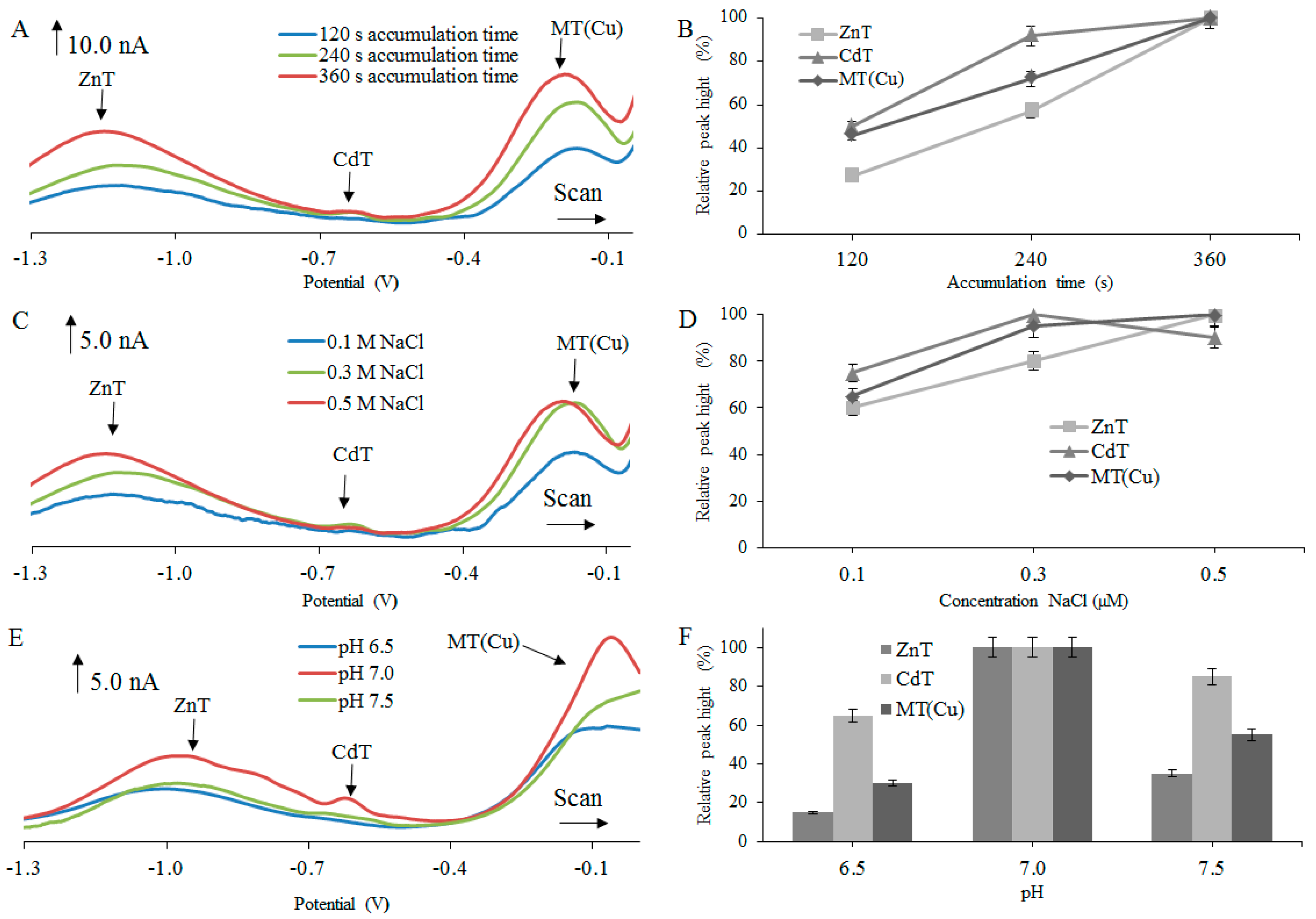
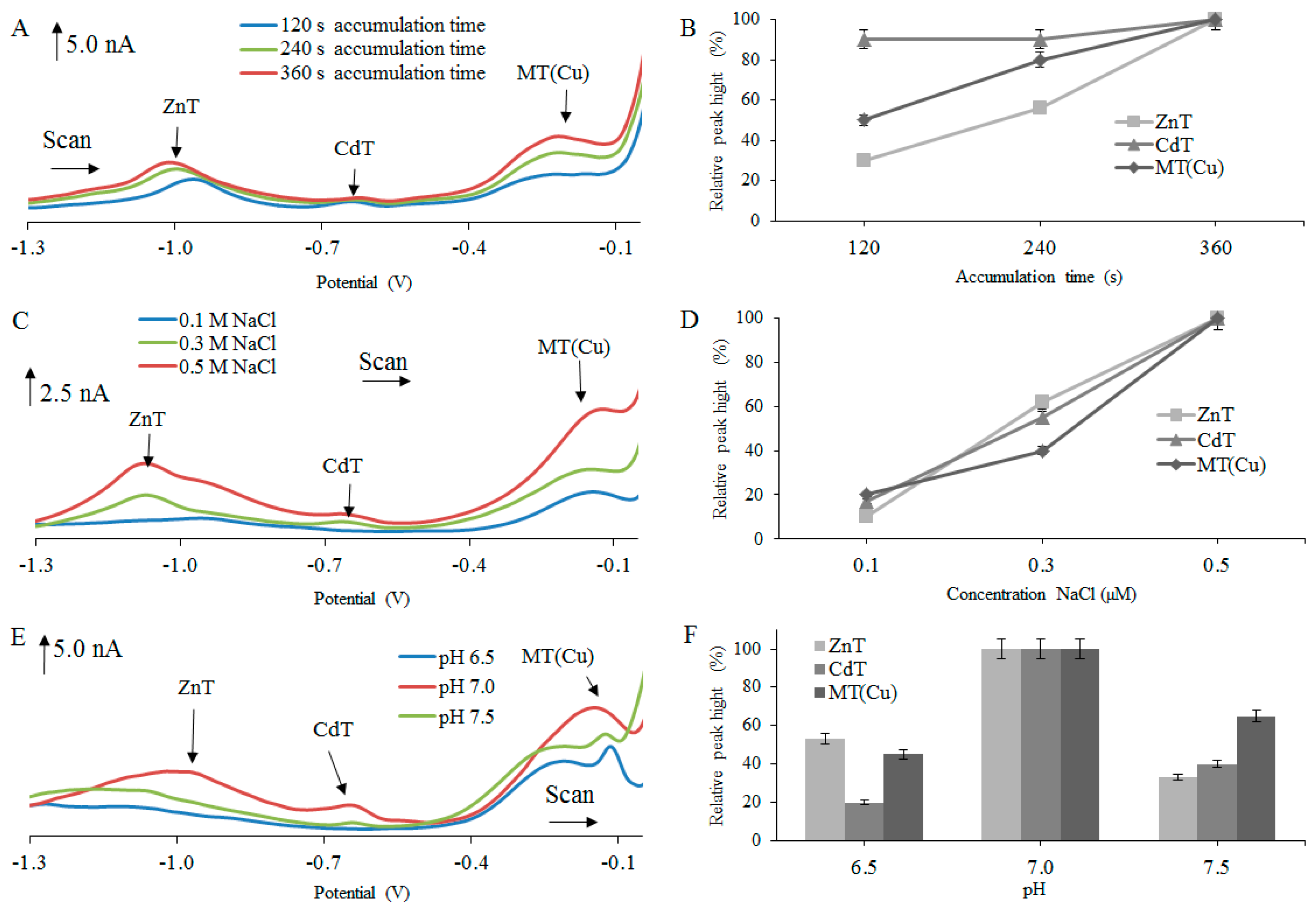
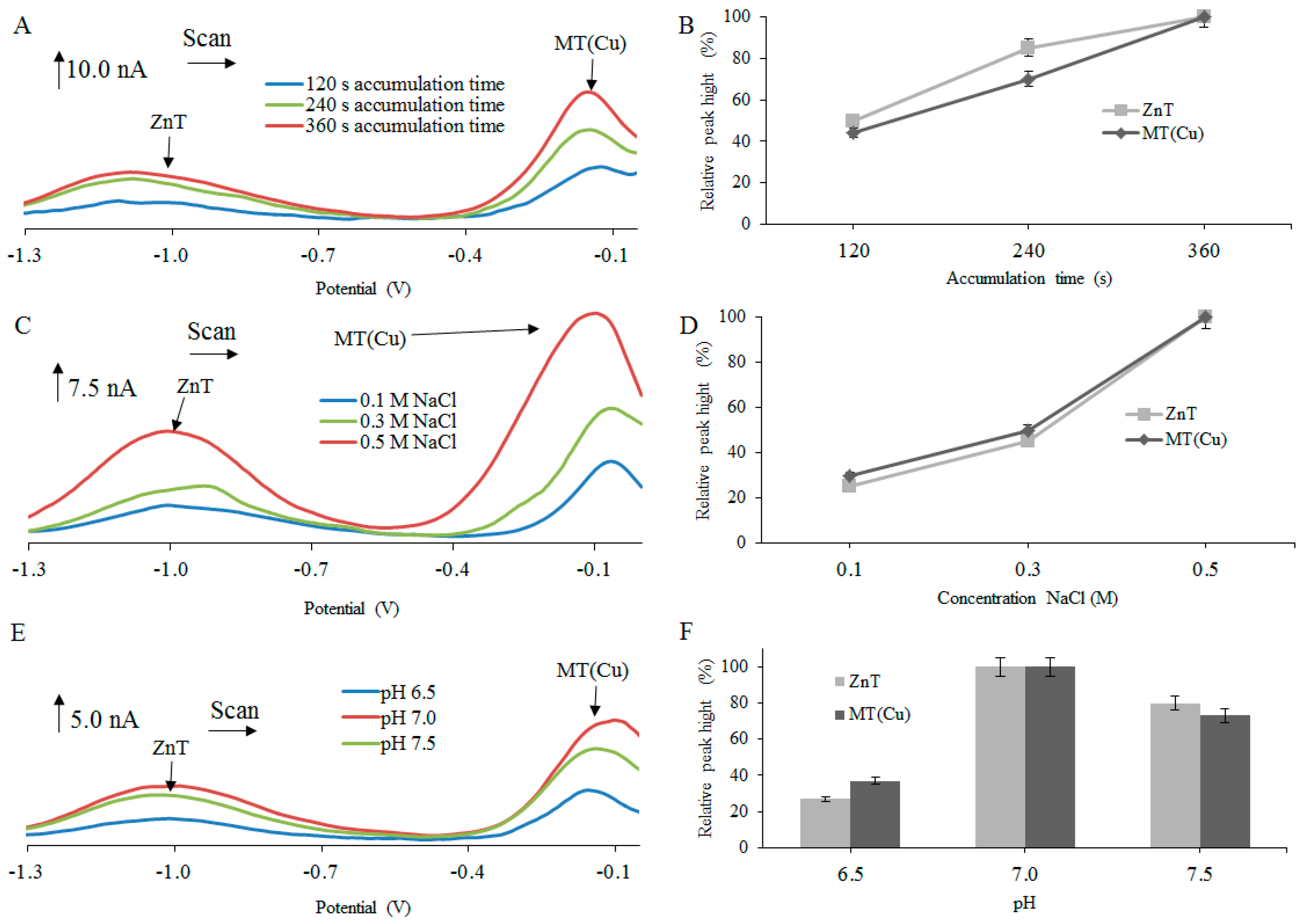
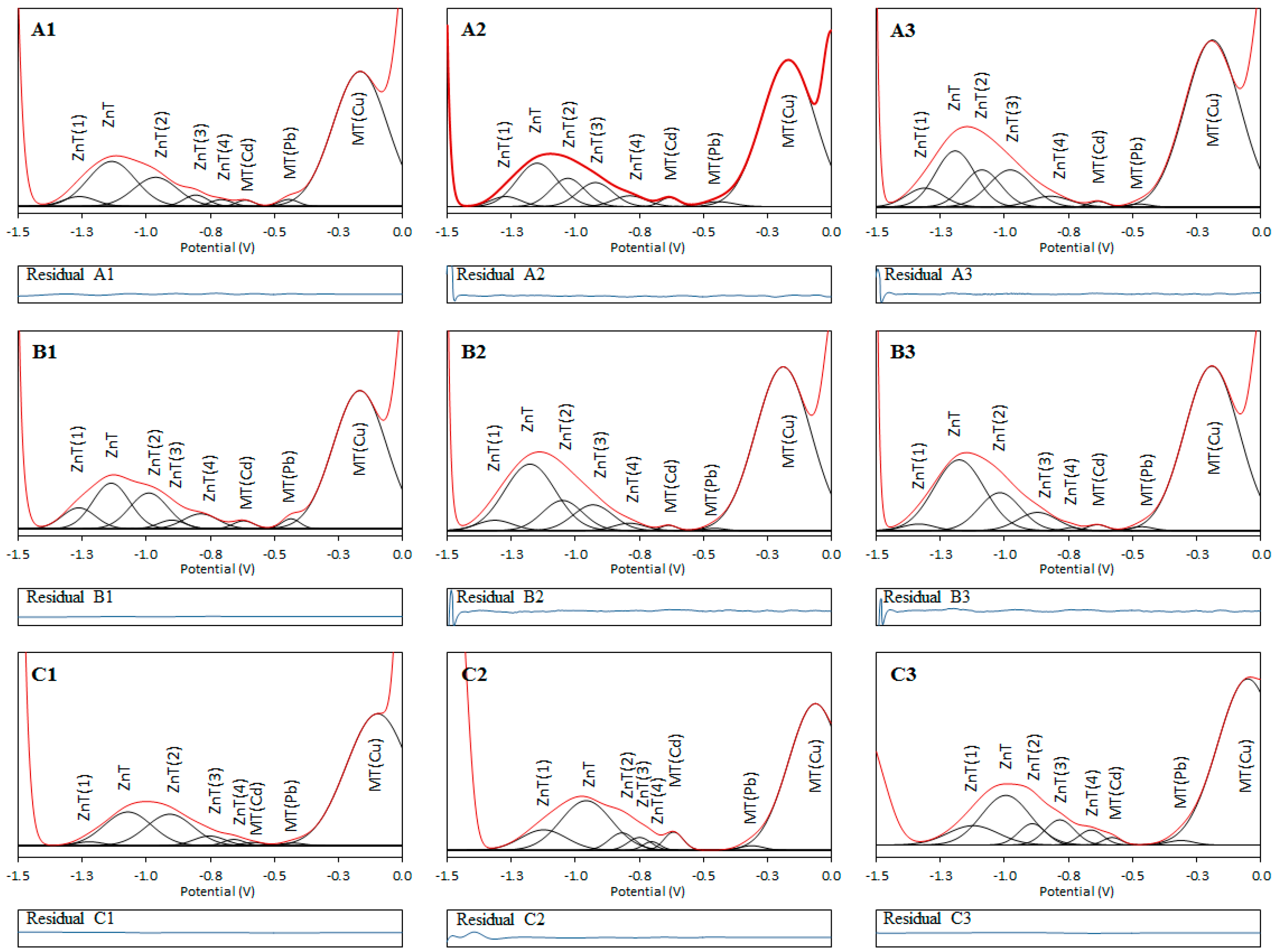

© 2017 by the authors. Licensee MDPI, Basel, Switzerland. This article is an open access article distributed under the terms and conditions of the Creative Commons Attribution (CC BY) license ( http://creativecommons.org/licenses/by/4.0/).
Share and Cite
Merlos Rodrigo, M.A.; Molina-López, J.; Jimenez Jimenez, A.M.; Planells Del Pozo, E.; Adam, P.; Eckschlager, T.; Zitka, O.; Richtera, L.; Adam, V. The Application of Curve Fitting on the Voltammograms of Various Isoforms of Metallothioneins–Metal Complexes. Int. J. Mol. Sci. 2017, 18, 610. https://doi.org/10.3390/ijms18030610
Merlos Rodrigo MA, Molina-López J, Jimenez Jimenez AM, Planells Del Pozo E, Adam P, Eckschlager T, Zitka O, Richtera L, Adam V. The Application of Curve Fitting on the Voltammograms of Various Isoforms of Metallothioneins–Metal Complexes. International Journal of Molecular Sciences. 2017; 18(3):610. https://doi.org/10.3390/ijms18030610
Chicago/Turabian StyleMerlos Rodrigo, Miguel Angel, Jorge Molina-López, Ana Maria Jimenez Jimenez, Elena Planells Del Pozo, Pavlina Adam, Tomas Eckschlager, Ondrej Zitka, Lukas Richtera, and Vojtech Adam. 2017. "The Application of Curve Fitting on the Voltammograms of Various Isoforms of Metallothioneins–Metal Complexes" International Journal of Molecular Sciences 18, no. 3: 610. https://doi.org/10.3390/ijms18030610







